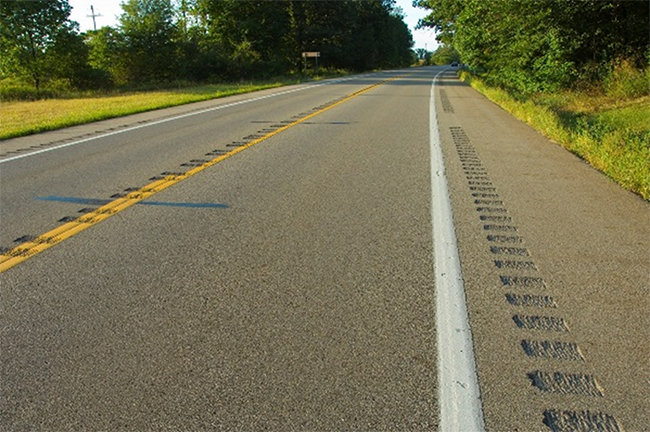|
Return to your Search Results
Return to Search page
Search the Noteworthy Practices database
Michigan DOT Reduces Crashes by 47 Percent by Implementing a Centerline Rumble Strip Initiative
Publication Year: 2015
What was the safety issue, problem, or gap?
From 2004-2007, lane departure crashes accounted for 17.2 percent of all crashes in Michigan, but 47.4 percent of all fatal crashes. Michigan Department of Transportation (MDOT) recognized that while the type and severity of the crashes had similarities, the location at which they occur is random. As a result, MDOT began a three-year statewide initiative in 2008 to install milled centerline rumble strips on all rural non-freeway highways with a posted speed limit of 55 mph, eventually including approximately 5,400 miles of non-freeway roadways. MDOT also installed shoulder rumble strips (SRS) on roadways with paved shoulders of at least 6 feet in width. This systemic initiative is to date the largest of its kind in the United States and provided a unique study opportunity. Consequently, MDOT wished to evaluate the impacts of these rumble strip installations on traffic safety and operation and pavement durability to provide guidance for future implementation both in Michigan and in other states. This evaluation study primarily focused on safety effectiveness of centerline rumble strips (CLRS), since the effectiveness of SRS had previously been established through numerous nationwide research and studies.
What were the key challenges that needed to be addressed before the new practice could be implemented?
- MDOT had to ensure that stakeholders were involved in the process and developed and circulated survey to capture the opinions and input of various road users.
- Additionally, MDOT developed a pair of rumble strip-based public service announcements for outreach.
- The installation of the rumble strips needed to be expedited in order to ensure valid research results.
Describe the new practice.
- Centerline rumble strips are a set of transverse grooves applied on the centerline of a roadway to alert inattentive (distracted, drowsy, unfocused, etc.) drivers who may unintentionally drift over the centerline.
- Rumble strips provide a tactile and audible warning to alert drivers.
- In 2008 MDOT began a three-year statewide CLRS installation initiative, including approximately 5,400 miles of 55 mph, non-freeway roadways over the three-year installation period.
- To efficiently roll out the rumble strip installations, the contracting process was streamlined by adding the work items to MDOT's annual pavement marking contracts with the direction to cut the rumble strips ahead of restriping the roadways.

Non-Freeway Shoulder and Centerline Rumble Strip Installation – M-66 in Calhoun County, Michigan
Key accomplishments, including roadway safety improvements.
- 47 percent reduction in total target crashes (head-on, sideswipe opposite and run-off-the-road left) and a 51 percent reduction in target fatal crashes, as well as reductions in other injuries
- Economic analysis resulted in a benefit-cost ratio in the range of 58:1 to 18:1 based on discount rate assumptions of 2 percent and 10 percent, respectively
- A road user survey indicated strong agreement among the respondents that CLRS are a beneficial safety improvement program
What technical and/or institutional changes resulted from the new practice?
- As a result of the initiative's success, installation of CLRS has become standard practice on trunkline routes in Michigan.
- Language in MDOT's Road Design Manual now dictates that CLRS be installed on all 55 mph 2- and 4-lane highways (regardless of whether a section is a passing or non-passing zone) where the lane plus paved shoulder width beyond the rumble strip exceeds 13' in width, with exceptions for high driveway densities and the presence of horse drawn buggies.
What benefits were realized as a result of the practice?
- Rumble strips on high-speed non-freeway highways improved driver performance in most traffic scenarios.
- CLRS did not contribute to short-term transverse cracking in asphalt pavements.
Contact
Mary Bramble
517-335-2837
BrambleM1@michigan.gov
Publication Year: 2015
Return to your Search Results
Return to Search page
Search the Noteworthy Practices database
|
